The dangers of drunk driving and texting while driving have been made clear, but Ford and Colonie Central High School recently attempted to drive that point home by allowing students to actually participate in both. Ford’s Driving Skills for Life program took over the high school’s parking lot on Thursday, Oct. 13, to set up three different driving courses for students. The courses were meant to teach them what happens when they either drive (with drunk goggles on), text while driving or go into a skid. “The biggest reason why we do Driving Skills for Life was is it give you the feel of the car and what they can do and what they can’t do,” said Mark Speck, lead facilitator for DSFL. “We also do the driving simply because it’s fun.” Speck said the goal is not to completely change the way many of the students drive, but to introduce them to the dangers of distracted driving. Some forms of distracted driving take away three cognitive functions. It can involve taking your eyes off the road, taking your hands off the steering wheel and not allowing your brain to completely focus on the task at hand. Chuck Deweese, assistant commissioner for Gov. Andrew Cuomo’s traffic safety committee, said this type of program could have been held at any school. Automobile accidents are the leading cause of teenager deaths, he said. “They are just learning to drive and we want to teach the right way how to handle a skid and basically just the dangers,” he said, pointing towards the cones. “These are just cones. You can kill a cone. In real life, you’re going to kill a human and the cost of living with that for the rest of your life is going to be with you.” It is possible to text and drive, Deweese said, but it isn’t possible to drive at a normal speed while texting at the same time. As he discussed this, one of the students driving through the course was moving at a snail’s pace as they tried to drive through the obstacle course. “They can text and drive,” he said. “The biggest reason you think you can do it is because you’ve done it. You’ve gone from point A to point B without getting killed while texting or talking on the phone, so you’ve had success doing that. And you’ll have success doing that over and over again. There will be one time you don’t have success and you will kill yourself or your friends or somebody else and you’ll go, ‘I didn’t mean it.’ Was that text really that important that you took out somebody’s family?” One of Deweese’s fears is that what the students learn during these demonstrations will only stick with them for the next month. Some of the kids, though, said going through the course has opened their eyes to just how bad they are at driving while trying to send a text. Julia Halburian, a junior at the high school, got a chance to drive while trying to text. In the car were three other individuals, including an instructor from the DSFL program. He first told her to drive around the course without any texting. The problem was, he continued to talk to her about country music, shifting her focus from the road to the conversation. Halburian ended up turning left at a sign that said right turn only. “I found texting and driving to be the most difficult one,” said Brendan Jeffers, a junior at Colonie High school, who went through all three of the courses. Some students said that they had never texted while driving, including Halburian. After driving through the obstacle course, though, she said it made her more aware of the dangers of texting and driving. “It’s an eye opener,” she said.
Assistant Principal Tim Nicholson said that the school felt it was important to invite all of the students to the presentation held that day and that it is important the school shows it cares for the students even when they are not at school. This is also a means to plant the seed in their heads early about the dangers of drunk driving and texting while driving. He also said with the evolution of technology it will make it even easier for teenagers to become distracted while driving. He said most of the accidents are mainly caused by texting while driving as opposed to drinking and driving. “This I think is as, or perhaps even more, important message as it is going to affect almost all teen drivers as opposed to alcohol which affects some,” Nicholson said. “This one is either 100 percent where they’ve either though about or have actually texted while driving.” Speck said that it appeared that many of the kids were receptive to the driving course and he believes it will have a positive effect on the children. Even if it only helps one of the students, he views it as a success. “You want to plant the seed of, ‘I should think about what I’m doing,’” Speck said. “That’s where I believe we’re very successful.”
Driving the point home
Leave Comment



